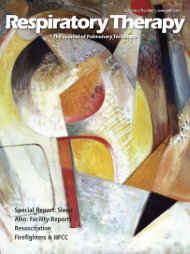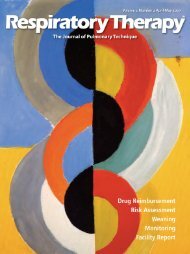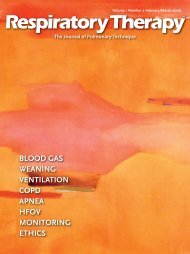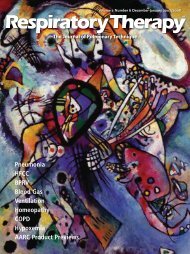RT 02-03 JJ07 main web - Respiratory Therapy Website
RT 02-03 JJ07 main web - Respiratory Therapy Website
RT 02-03 JJ07 main web - Respiratory Therapy Website
You also want an ePaper? Increase the reach of your titles
YUMPU automatically turns print PDFs into web optimized ePapers that Google loves.
to record rapid eye movements, and the electromyogram (EMG)<br />
to record submental and tibial muscle activity, thus allowing<br />
movement arousals to be detected. There is some debate about<br />
the value of precise sleep staging in the diagnosis of<br />
straightforward conditions such as obstructive sleep apnea in an<br />
otherwise healthy child with adenoidal hypertrophy, in which<br />
case quiet sleep can be differentiated from active sleep using<br />
cardiorespiratory and behavioral variables. Additionally,<br />
advances in technology, such as neural network analysis, 25 have<br />
the potential to simplify this process.<br />
An audio video recording during sleep is usually performed as<br />
part of the PSG as it is helpful in correlating physiological<br />
disturbances with clinical or behavioural findings. A trained<br />
technician is required to supervise the study to assure quality.<br />
Therefore, PSG is expensive and time consuming to perform.<br />
Additionally, there are limited resources for full<br />
polysomnography in children in the United Kingdom and other<br />
countries. Therefore, researchers have been prompted to<br />
evaluate other options for the assessment of sleep disordered<br />
breathing either as diagnostic or screening investigations.<br />
Pulse oximetry is the most widely used of the available<br />
screening methods. In some circumstances it can be useful, but<br />
it does have significant limitations. The finding of intermittent<br />
episodes of hypoxemia in a snoring child is highly suggestive of<br />
OSAS. Stradling and others showed that pulse oximetry had 93%<br />
sensitivity and 86% specificity for detecting OSAS. 26 Brouillette<br />
and others 27 showed a high positive predictive value for pulse<br />
oximetry but also a high false negative rate. Sleep related<br />
breathing problems are more likely to occur during rapid eye<br />
movement (REM) than during non-REM sleep. It is not possible<br />
to determine if adequate periods of REM sleep have been<br />
included in a sleep study using pulse oximetry alone. Some<br />
children who snore have significant disturbance in their<br />
breathing and sleep without recurrent episodes of hypoxemia.<br />
There is evidence that continuous partial airway obstruction<br />
may be the most common presentation of disordered breathing<br />
during sleep in children of all ages, 28, 29 and this will not be<br />
detected by pulse oximetry. Additionally, pulse oximetry is not a<br />
reliable indicator of severity of OSAS. 30 This is potentially<br />
important in preoperative assessment, particularly of high risk<br />
children with adenotonsillar hypertrophy who have an increased<br />
risk of perioperative complications with severe disease. Pulse<br />
oximetry does however have an important role in assessing<br />
oxygenation during sleep in children with chronic lung disease<br />
and neuromuscular disorders.<br />
Audio and video taping have also been used to screen for sleep<br />
disordered breathing. Recording the snoring sound can be used<br />
to detect apneas, but it cannot differentiate between central and<br />
obstructive apnea. 31 Goldstein and colleagues 32 found that a<br />
sound recording was positive when compared to PSG only 50%<br />
of the time. Lamm and others 33 found that home audiotapes<br />
were not sufficiently specific to reliably distinguish primary<br />
snoring from OSAS. A videotape of a child during sleep can<br />
provide useful information. It allows the physician an<br />
opportunity to observe disturbed sleep. However it is not<br />
practical in a clinical context to record and view more than a<br />
limited portion of the sleep period. The severity of sleep<br />
disordered breathing may vary throughout the night. The design<br />
of sophisticated computer systems for analysing video material<br />
may circumvent this problem. Combining audiotaping with<br />
pulse oximetry adds to the diagnostic value; 31 however, lack of<br />
arousal data and information to stage sleep re<strong>main</strong>s a problem.<br />
Due to the limitations of single channel recording systems,<br />
attempts have been made to develop simple multichannel<br />
devices that are suitable for unattended home use or with<br />
minimal supervision. There is limited evidence of the<br />
performance of these devices in children to date, but recent<br />
studies of such monitors compared in both laboratory and home<br />
conditions with PSG, have shown that obstructive<br />
apnea/hypopnea syndrome in adults can be diagnosed<br />
satisfactorily in a substantial proportion of cases. 34 Although<br />
such comparisons do not exist for children, unattended home<br />
PSG has been evaluated in a research context and found to<br />
provide acceptably high quality data. 35 Therefore, this represents<br />
a potentially useful and cost effective approach to the diagnosis<br />
of obstructive apnea in children that deserves further<br />
evaluation.<br />
What abnormalities can be detected?<br />
Obstructive sleep apnea and upper airway resistance<br />
syndromes: The most common indication for performing sleep<br />
studies in children is for the detection of obstructive sleep<br />
apnea syndrome (OSAS). OSAS in children is characterised by<br />
recurrent events of partial or complete airway obstruction<br />
during sleep, resulting in disruption in normal ventilation and<br />
sleep patterns, 36 but rarely with prolonged apnea. Episodes of<br />
obstruction occur primarily during REM sleep, in contrast with<br />
obstructive apneas in adults, which are mostly non-REM<br />
phenomena. The prevalence of OSAS in preschool children is<br />
estimated to be 1–3%. 37,38<br />
The majority of cases of OSAS in children are associated with<br />
adentonsillar hypertrophy. It is most commonly diagnosed<br />
between the ages of 2 and 8 years when the tonsils and<br />
adenoids are largest in relation to the upper airway size.<br />
However, the symptoms of OSAS are not simply related to<br />
structural narrowing of the airway by physical obstruction. This<br />
is supported by studies which have shown no correlation<br />
between upper airway or adenotonsillar size and OSAS, 39,40 and<br />
by studies in which children have failed to show improvement<br />
after adenotonsillectomy despite the lack of other risk factors<br />
for OSAS. 21 A combination of structural and neuromotor<br />
abnormalities is likely to be important for OSAS to develop. The<br />
role that these two factors have will vary in different<br />
individuals. In children with adenotonsillar hypertrophy,<br />
structural factors will tend to predominate, although subtle<br />
neuromotor abnormalities are likely also to be present. 41 In<br />
children with cerebral palsy and neurodisability, it is more likely<br />
that neuromotor factors will be to the fore.<br />
The classical picture of OSAS in which snoring is associated<br />
with obstructive apnea and hypoxemia represents only a small<br />
proportion of children with sleep disordered breathing. It is now<br />
widely recognised that a spectrum of abnormalities exists 42<br />
between primary snoring and classical OSAS, with two further<br />
conditions, upper airway resistance syndrome and obstructive<br />
hypoventilation being intermediate between the extremes. It is<br />
also recognised that children may move up or down this<br />
spectrum in response to seasonal variations and with age or<br />
growth. Therefore, these should not be regarded as static<br />
conditions. Upper airway resistance syndrome (UARS) is<br />
characterised by increased upper airway resistance and<br />
increased work of breathing during sleep sufficient to cause<br />
frequent microarousals (brief arousals,











